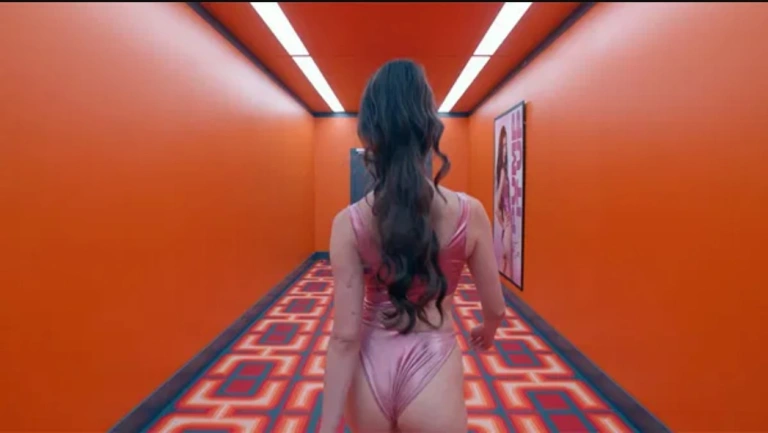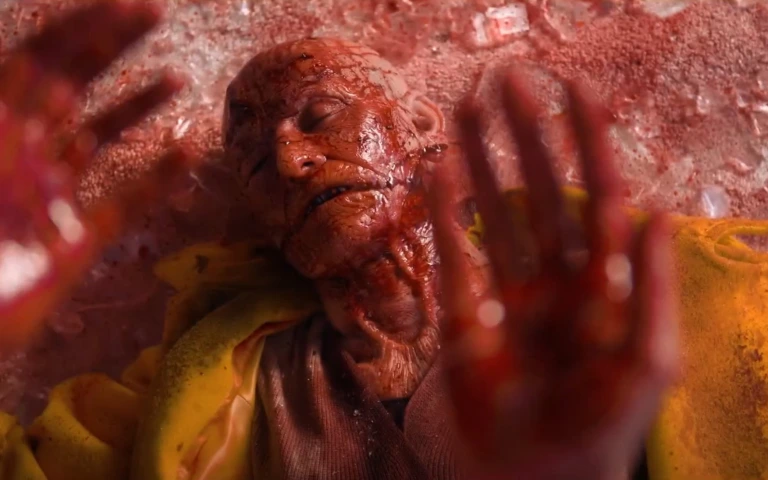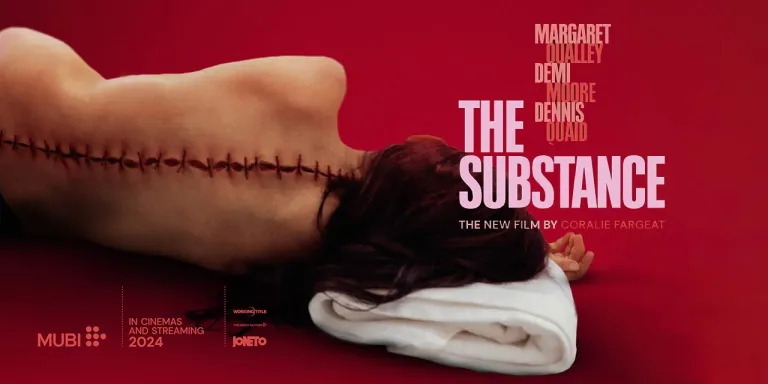Horror films often get a bad rap from critics—seen as shallow, cheap thrills filled with jump scares and gore. But The Substance breaks the mold. This grotesque, bizarre horror film took home Best Screenplay at the Cannes Film Festival, holds a 90% rating on Rotten Tomatoes, and scored 78 on Metacritic.
It’s a film that doesn’t rely on jump scares to haunt the audience. Instead, it lingers in your mind, crawling under your skin with a compelling narrative that serves as a vivid, visceral warning—like a red alert flashing in blood.
Note: The following contains spoilers

A Foreboding Opening Montage
The film opens with a fascinating and symbolic montage: a star with the name “Elisabeth Sparkle” is unveiled on the Hollywood Walk of Fame. Time passes. Her glory days fade. The camera lingers on the now-forgotten star, covered in snow, until a man drops his hot dog on it—leaving a red ketchup smear across her name. That red stain? A grim prelude to what’s coming.
The Fall of Elisabeth Sparkle
Elisabeth Sparkle is a fading star. Her youth and fame are gone. Wrinkles line her face, her skin dries, her body sags—age is catching up. In a deep depression over her lost youth and forgotten name, Elisabeth discovers a mysterious “substance”—a miracle drug that allows her to shed her aging body and transform into a youthful, radiant version of herself named Sue.
The Rules of the Game
But this miracle comes with rules:
- The activation drug can only be used once.
- Both the old and new bodies must be maintained with a special daily serum.
- Bodies must be swapped weekly—one week as Elisabeth, one week as Sue.
As Sue, Elisabeth regains everything: beauty, fame, attention, joy. But reality is never that simple. Sue begins to crave more time. Elisabeth, in contrast, grows more miserable, eagerly waiting her turn to escape back into youth. The balance breaks. Sue pushes her time limit: “Just a little longer,” “just one more time.” But it’s never the last time.

The Warning Hidden in the Flesh
Time is cruel. The more Sue flourishes, the more Elisabeth withers. They become two people—two lives, two personalities. And through this transformation, the film quietly whispers a deeper truth:
“When we’re young and indulgent, we pay for it later.”
Have you ever smoked heavily, telling yourself you’ll quit later?
Ever binged on fast food or sugar, saying, “Just this once”?
Drank to blackout, promising never again—only to repeat the cycle?
The Substance is a red flag—red like blood. The punishment Elisabeth endures is gruesome and physical. Her body mutates, disintegrates—inside and out. Pain becomes her currency. Horror becomes her mirror.
Body Horror Without Jump Scares
The film builds dread not through loud jolts, but through inevitable decay. Each consequence, each transformation escalates the terror. If you’ve seen The Fly or read Junji Ito’s manga Uzumaki, you’ll understand this kind of horror—slow, strange, and deeply disturbing.
Fame, Vanity, and Media Manipulation
Beyond personal indulgence, the film also critiques media and celebrity culture—a world that chews up stars and spits them out. It’s cold, shallow, and exploitative. When Sue becomes a sensation, her manager Harvey boasts, “I created her.” In truth, he created a monster—Elisasue, the terrifying blend of Elisabeth and Sue.
This transformation begins when Sue violates the cardinal rule: she activates the miracle drug a second time. That moment kicks off the film’s third and final chapter—its most grotesque and horrifying, reminiscent of Stephen King’s Carrie.
Personally, I found this third chapter excessive. If I could change anything, I’d have climaxed the story at the end of Chapter 2. Sue, having lost her teeth, is forced to appear in public. I would place the second activation earlier, leading to a slow descent into monstrous form—culminating in the New Year’s Eve show, where Elisasue is finally revealed in all her horrific glory.
Love Your Body, Don’t Indulge It
The message? Learn to love your body. Not by pampering it with shortcuts, but by respecting it—understanding that our present habits will echo into the future.

Performances That Elevate the Story
Demi Moore (as Elisabeth) and Margaret Qualley (as Sue) shine—especially Moore, whose portrayal of Elisabeth’s psychological decline is deeply affecting. She transitions from a middle-aged woman into a bitter, grotesque figure with nuance and raw emotion.
Makeup, Design, and Art Direction
For a film so focused on the body, the practical effects, makeup, and production design are astonishing. I sincerely hope it earns accolades for these aspects—it’s more than deserved.
Visual Language and Cinematic Style
The cinematography is another triumph. With modern-art-inspired compositions, paired with sound design and pacing, The Substance becomes a true horror art piece. The dreamy visuals and passage-of-time sequences recall Requiem for a Dream, while the blood-red hallways evoke Kubrick’s The Shining.
A Frankenstein of Film Influence
In many ways, The Substance feels like a twisted child of classics. It channels the philosophical horror of Oscar Wilde’s The Picture of Dorian Gray, the transformation of The Fly, the psychological disintegration of Requiem for a Dream, the tech dread of Black Mirror, and the bloodbath finale of Carrie.
This is a grotesque, haunting, and intelligent horror film—a rare blend. It belongs alongside the greats: The Fly, The Shining, Carrie, Psycho. More than just disturbing, it forces us to reflect on aging, vanity, and how we treat our own bodies. It’s terrifying, yes—but also deeply human.






